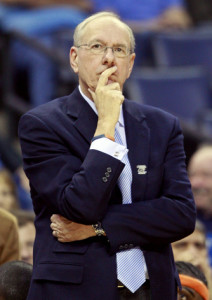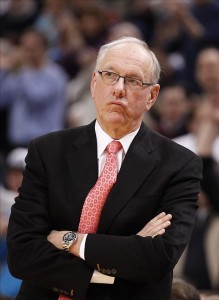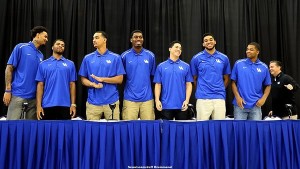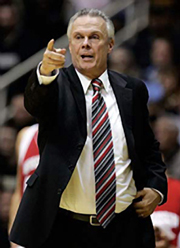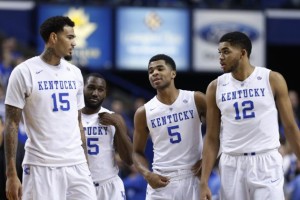Final Four Berth For Syracuse Calls for Trip Down Memory Lane 1
Syracuse is back in the Final Four for men’s basketball! The Orange are making their second trip to college basketball’s biggest stage in the last four seasons, the shortest time between trips for the school in the history of the program which has now reached six Final Fours. This is the fifth time that Syracuse coach Jim Boeheim has lead the Orange to the Final Four in this his 40th year as head coach of his alma mater. Syracuse punched its ticket to the Final Four with a thrilling 68-62 win over top-seeded Virginia in the NCAA Tournament’s Midwest Regional final on Sunday March 27 at the United Center in Chicago. The Orange overcame a 16-point second-half deficit to post the victory.
Syracuse is only the fourth double digit seed to ever advance to the Final Four and the first 10 seed to do so. The Orange will face Atlantic Coast Conference rival North Carolina in the national semifinals at NRG Stadium in Houston, TX. The Tarheels, the East Regional champions, are the tournament’s only number one seed to make it to the Final Four. A pair of two seeds will collide in the other national semifinal with South Regional champion Villanova meeting West Regional champion Oklahoma.
This improbable run by Syracuse marks what March Madness is all about. Living on the edge. Dramatic finishes behind thrilling comeback efforts. A team that was on the NCAA bubble but has shown why they deserved to be in the tournament. A gutsy and gritty team that has thrived off their chemistry. The Orange have only been ranked once all season which was on November 30 when they placed 14th in the AP top 25 poll and 19th in the USA Today Coaches Poll. They have only received votes on three other occasions during the season with those coming on December 7 and 14 and again on February 15. Syracuse was not even ranked in either of these preseason polls.
Although schools like UCLA (17, 11), Kentucky (17, 8), Duke (16, 5), Kansas (14, 3), Indiana (8, 5), Ohio State (10, 1), Michigan State (9, 2), and Louisville (10, 3) are college basketball thoroughbreds with a combined 101 Final Four appearances and 38 NCAA championships among them, the Orange program has its own high caliber history. The Syracuse program has stood the test of time by reaching at least one Final Four in every decade since the 1970’s started. That peaked in 2003 when the Orange won its’ only national championship.
Boeheim was an assistant coach on the 1974-75 Syracuse team that reached the school’s first Final Four. This is the first time that the Orange have made two trips to the Final Four in the same decade. Furthermore, Boeheim and Syracuse have made some of their loudest statements by beating some of those storied aforementioned schools in their Final Four seasons. The NCAA Tournament history of the Orange includes two wins each against Kansas and North Carolina and one win over Indiana in years that they went to the Final Four. Syracuse beat Kansas in the 1996 West Regional final and defeated them to win it all in 2003. The Orange beat North Carolina 78-76 in the semifinal of the East Regional in 1975 and again in the 1987 East Regional final. Syracuse’s win over Indiana came in the Sweet 16 in 2013.
Boeheim was elected to the Naismith Memorial Basketball Hall of Fame in 2005 and has beaten fellow hall-of-famers in Dean Smith, Roy Williams, and Rick Pitino in NCAA Tournament play at least once each. This all supports the fact that Boeheim and the Orange program have risen to beat some of the best in the game when the stakes are the highest. In the process, he has positioned Syracuse in the national spotlight consistently throughout his career as a national contender year in and year out, despite not having the same NCAA Tournament accomplishments of other storied schools as is measured in quantity.
However quality has always been there and has continued even after reaching the program’s pinnacle in 2003. Since cutting down the nets as national champions 13 years ago, Boeheim has had the Orange in postseason play every year but one including 10 trips to the NCAA Tournament. During that same time, he has also led Syracuse to two Big East outright regular season championships (2010, ‘12), guided the Orange to four appearances (2005, ’06, ’09, ’13) and two wins (2005, ’06) in Big East Tournament championship games, had multiple teams rise to the number one ranking in the country, lead two teams to number one seeds in the NCAA Tournament (2010, ’12), garnered the AP national coach-of-the-year honor in 2010, and lead Syracuse to a school record 25-0 start (2013-14). Boeheim has done some of the best work of his career during this time and the teams, players, and coaches he has had reflect nothing but class and excellence for his program as well as the game.
Despite not always getting the top 20 recruits to become part of the Orange, Boeheim has been a steady example of how to use coaching, leadership, and a fierce competitive nature to get the best out of his players and teams as a whole. While he has had talented players on his Final Four teams such as Derrick Coleman, John Wallace, Carmelo Anthony, and Michael Carter-Williams, an equally important factor if not more has been the chemistry he has had on his teams. Chemistry refers to the way people work together in their interactions with one another. The more everyone can work together in support of a common goal, the better chemistry they have and this can have a positive impact on winning. Boeheim is the epitome of this and it has always stood out as an admirable quality in his coaching over his 40 years at the helm.
Chemistry is something that has been a common thread to all the Final Four teams in Syracuse history. The Orange have had a talented key player on each of their Final Four teams. However their other four starters over the years have been highly productive making them multi-dimensional. For example Howard Triche and Greg Monroe were senior co-captains that brought steady production and leadership during the school’s 1987 Final Four season. Even when Syracuse won the national title in 2003, he had serviceable role players come off the bench in Billy Edelin, Josh Pace, and Jeremy McNeil. While Boeheim has not always had a lot of depth, he has still been able to turn to a player or two off the bench to contribute and battle the opposing coach with the matchup game. Look no further to a player like Steven Thompson who was a key reserve on the 1987 Final Four team and then started for three more years.
Over the years, the Orange have played a lot of thrilling games that have captivated the hearts of Syracuse fans throughout Central, NY and captured national television audiences. There have been thrilling and dramatic finishes and elaborate wins where the Orange strutted their stuff. So here is a trip down memory lane for Syracuse fans and alumni of the program. The school’s five previous trips to the Final Four have been exciting. More thrilling dramatics could be in store in Houston this weekend. Here is a look back at what the Orange have done in their previous trips to the Final Four. Perhaps this look back offers a glimpse into the immediate future for Syracuse. If nothing else, thrilling competition usually takes place when the Orange are in the Final Four. Read the rest of this entry →
